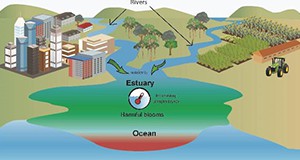 Climate change is expected to result in increased temperatures of nearshore ocean water, and this could lead to increased growth of harmful microorganisms. These include algae that form noxious or toxic blooms, including red tides, and bacteria and other pathogens. This situation could have negative consequences in regard to human health and also Florida’s ocean-related economy. This 6-page fact sheet discusses projected ocean temperatures, how harmful microorganisms living in the ocean might respond, and how this might affect people, and identifies actions that could be taken to reduce these impacts. Written by Karl Havens, and published by Florida Sea Grant, June 2015.
Climate change is expected to result in increased temperatures of nearshore ocean water, and this could lead to increased growth of harmful microorganisms. These include algae that form noxious or toxic blooms, including red tides, and bacteria and other pathogens. This situation could have negative consequences in regard to human health and also Florida’s ocean-related economy. This 6-page fact sheet discusses projected ocean temperatures, how harmful microorganisms living in the ocean might respond, and how this might affect people, and identifies actions that could be taken to reduce these impacts. Written by Karl Havens, and published by Florida Sea Grant, June 2015.
http://edis.ifas.ufl.edu/sg136
Tag: Red Tides
Strategies to Address Red Tide Events in Florida: Results of a 2010 Survey of Coastal Residents (FE891)
Residents in coastal communities might oppose programs for preventing, controlling, or mitigating the effects of these harmful algal blooms if they would increase costs to residents or would cause harm to other aspects of the marine environment. This 6-page report presents the results of a survey intended to help summarize public opinion, inform policy makers, and evaluate possible programs for use in Florida. Written by Sherry L. Larkin, Kristen M. Lucas, Charles M. Adams, and John Stevely, and published by the UF Department of Food and Resource Economics, April 2011.
http://edis.ifas.ufl.edu/fe891
FE711/FE711 Public Costs of Florida Red Tides, 2007
FE711, a 4-page executive summary by Kimberly L. Morgan, Sherry L. Larkin, and Charles M. Adams, summarizes Public Costs of Florida Red Tides: A Survey of Coastal Managers, a study which attempted to quantify public expenditures and procedures resulting from red tide-related management and mitigation issues. Includes references. Published by the UF Department of Food and Resource Economics, June 2008.
http://edis.ifas.ufl.edu/FE711